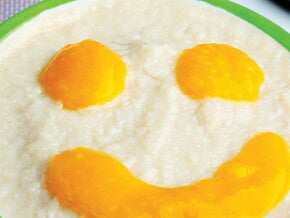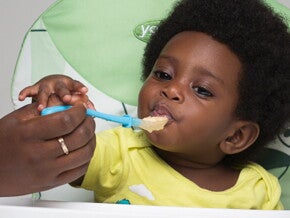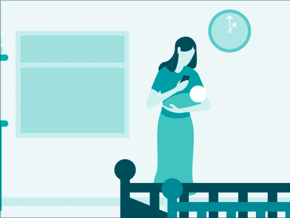
Childproofing Your Home: Safety first!
Your house is about to become home to all kinds of firsts for your new family addition. Make sure everyone can share every special moment in a safe environment where your baby can thrive!
Home safety: Preparing early
Start thinking about potential dangers in your home as soon as possible (it’s never too early, you don’t need to wait for crawling). Get a baby’s-eye-view by getting down on the floor to identify possible hazards.
Getting you and your caregivers ready
Help prepare anyone who’ll be taking care of your baby for unexpected accidents, illnesses and other events:
- As much as possible, be abreast with basic information on health and safety in the home environment
- Add emergency numbers to your phone’s contacts, post them by any phone or common areas in the house. Provide clear information babysitters or other caregivers.
- Keep a first-aid kit in your home (store-bought kits work, or any durable container that allows you to add the contents yourself).
- Travel with your first-aid kit, too!
Raising your toxin awareness
So you can ensure they’re stored safely out of reach in your home, garage or storage shed, here’s a list of toxins that could harm your baby (the risk of being poisoned is higher for kids than adults, after all).
- Medicines and vitamins
- Perfumes and other personal care products
- Household chemicals and cleaning products
- Insecticides, Pesticides and lawn-care products
- Charcoal and lighter fluid
- Paint thinner, paint remover and turpentine
Lock it up! One way to protect your baby? Use child-proof locks to secure cabinets that contain poisonous substances.
For more information on this topic, you can contact appropriate authorities.
Home safety: Adjusting with your toddler
Crawling brings with it new adventures and safety challenges, and you’ll want to step up your safeguarding game even more before your little one starts sprinting from room to room. (Can you say, “Olympics”?)
Stay one step ahead by anticipating potential dangers. It’ll help you protect your child from injury and give you a chance to relax and enjoy your time together.
Inspecting your home: Your checklist
How can you help eliminate some of the most common safety hazards? Your own overall home inspection!
When you start childproofing your home, follow this guide to help keep your toddler safe.
- Lock up and keep all hazardous or poisonous materials out of your child’s reach.
- Think round corners on everything (Cover sharp furniture corners with guards and check for sharp objects on toys, baby cots, play areas and strollers).
- Install vent locks or window guards on upper-storey windows to keep them from opening more than 3½" (9cm).
- Keep floors clean and vacuumed because any little treasure could end up in your little one’s mouth—it not only sounds gross, it’s a potential choking hazard.
- Eliminate tablecloths (your toddler will do all the impressing).
- Use plastic instead of glass every chance you get.
- Keep your purse out of reach (especially if it holds make-up, medicine, lighter, coins)).
- Secure your TV or its stand to the wall. (If you can’t secure it, at the very least make sure your TV stand has a wide, sturdy base and the TV is not near the edge.)
- Stop things that spin and keep hazards like air fans and stationary bikes out of reach.
- Keep everything in its original container to avoid mix-ups between food and poisons.
Childproofing: Room by room
Kitchen
- Use a safety gate to keep your toddler out, especially if you’re not around.
- Safety latch all doors and cabinets (the ones that hide cleaners, knives, scissors or glass, especially).
- Keep all electrical cords out of reach.
- Remove small magnets from the fridge as they pose choking hazards.
- Use the top shelf for glass items in the fridge.
- Turn pot handles toward the back of the stove.
- Cook with the back burners whenever possible.
- Never hold hot liquids over your child.
- Keep hot liquid containers away from counter edges and off tablecloths.
- Dispose of plastic grocery/shopping and big plastic bags immediately, they can cause suffocation.
Bedroom
- Make sure closets and wardrobes can be opened from the inside (you don’t want your little one getting trapped inside).
- Choose a tight-fitting baby cot mattress that fits your tot’s cot snugly and doesn’t move around—if you can fit more than two fingers (3 cm or 115⁄16") between the cot and the edge of the mattress, it’s not snug enough.
- Make sure the cot bars have no spaces more than 6 cm (2 3⁄8") apart so your youngster’s tiny head can’t get stuck.
- Keep all windows securely latched.
- Place the cot away from the window if space allows.
- Remove all curtain and blind cords from around the cot to avoid strangulation.
- Install cordless window coverings wherever possible, they’re the safest option.
- Keep cords up high and out of reach if you cannot replace your corded window coverings (Just install a cleat or tie-down device up high on the wall.
- Take care with any nightlights (their brightness and colours are hard to resist) by making sure they cannot be removed from the socket without a screwdriver and they’re placed out of reach.
Bathroom
- Always go with your child to the bathroom. (Potty training—fun!)
- Place a lock on all your toilets when your little one isn’t using them.
- Always check water temperature at bath time.
- NEVER leave your toddler in the bathtub alone or unattended as infants and toddlers can drown in as little as 2" (inches) of water.
- Don’t keep large buckets of liquid because children can fall in headfirst and may not be able to get out.
- Lock up cabinets containing medicines, cleaners, perfumes, or make-up.
Gates
Need to keep your travelling toddler in a room or two? Safety gates are great. Just use a straight-slatted, screw-mounted gate at the top and the bottom when you’re blocking off the stairs (and never use pressure gates at the top).
Toys
- Think big for children under 3 years (when the’yre at the greatest risk of choking).
- Use the toilet paper roll test from 0 to 3 years. Try fitting your toddler’s toy through a toilet paper roll, if it fits, or parts of it fit, then it’s not safe.
- Check the "recommended age" advisory included with most toys.
- Consider your child’s abilities and level of maturity. The mouth still the first place everything goes? Steer clear of toys with small pieces.
- Never give toys with projectiles to a child under the age of 4.
- Look for toys that are well put together (i.e. Check for reinforced seams on stuffed animals—they should also be free of buttons, yarn, ribbons, and any other goodies than can be pulled off).
- Go cordless wherever you can, by avoiding older toys that rely on them, and by removing the dangling mobile above the baby cot that your little one can now reach.
- Avoid toys with strings and cords that are long enough that they could end up wrapped around a little one’s neck.
- (Hand-me-downs!) Make sure used toys are still in good condition and any worn or frayed pieces, buttons, batteries, ribbons and eyes are still secure.
Stay away from magnets. Often used in toys, small, powerful magnets can fall out and are easily swallowed. It’s rare obviously, but two or more swallowed magnets can be attracted to each other through thin intestinal walls, causing twisting, which can lead to holes, blockages, infection or worse if left untreated.


















